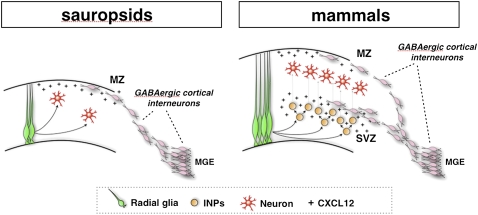Figure 7.
Model of cortical evolution based on INP function. (Left) During cortical development in the sauropsids (reptile and birds), glutamatergic neurons originate from direct differentiation of radial glia cells, while cortical GABAergic interneurons derive from the MGE in ventral telencephalon. Interneuron migration follows mainly a tangential stream coinciding with the MZ, probably sustained by superficial meningeal membranes secreting at least Cxcl12. (Right) In developing mammalian cortices, a large number of INPs arises to constitute the SVZ, which promotes the expansion of the excitatory neuronal pool and results in a larger and thicker cerebral cortex organized in six layers. To keep the functional balance between excitation and inhibition, INPs develop the ability to attract additional GABAergic interneurons, through at least expression of Cxcl12, giving rise to a supplementary tangential route of migration over the SVZ compartment.

